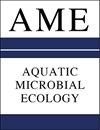哥伦比亚河下游浮游植物的季节和年际变化(2005-2018):环境变异性和大型藻华形成硅藻的减少
IF 1.1
4区 环境科学与生态学
Q3 ECOLOGY
引用次数: 4
摘要
了解生物和非生物因素对河流浮游植物动态的影响是具有挑战性的,特别是当富营养化、入侵物种和气候变化等人为压力源改变了这些关系时。我们检查了来自哥伦比亚河(美国太平洋西北部最大的河流)的14年(2005年1月至2018年12月)浮游植物和水质变量数据集,以及浮游动物和营养物质浓度,以确定浮游植物组合结构的季节性和年际模式及其环境关联。非度量多维尺度、聚类和指示种分析表明:(1)春/夏存在硅藻/鞭毛虫聚类,与叶绿素a、排放、纤毛虫和石藻有关;(2)夏末秋初出现蓝藻/绿藻群,水温升高、透明度提高,出现了入侵的桡足类forbesi Pseudodiaptomus和入侵的亚洲蛤Corbicula fluminea;(3)丰度和生物量最低的混合类群冬季群。营养物质与观察到的结构模式没有很强的联系。浮游植物的开花持续时间在年际之间有所不同,在春季短开花的年份和持续数月的年份之间。近年来,台湾硅藻的春季开花减少,让位于混合硅藻组合的开花。此外,高温、低流量和更多入侵的浮游动物与蓝藻华有关,这表明太平洋西北地区气候变化导致的温度升高和河流流量减少可能会进一步影响夏末/初秋哥伦比亚河的浮游生物群落。本文章由计算机程序翻译,如有差异,请以英文原文为准。
Seasonal and interannual variation in lower Columbia River phytoplankton (2005-2018): environmental variability and a decline in large bloom-forming diatoms
Understanding the influence of biotic and abiotic factors on riverine phytoplankton dynamics is challenging, particularly as anthropogenic stressors such as eutrophication, invasive species, and climate change alter these relationships. We examined a 14 yr (January 2005 to December 2018) dataset of phytoplankton and water quality variables, along with zooplankton and nutrient concentrations, from the Columbia River (the largest river in the US Pacific Northwest) to identify seasonal and interannual patterns of phytoplankton assemblage structure and their environmental associations. Non-metric multidimensional scaling, cluster, and indicator species analyses revealed: (1) a diatom/flagellate cluster in spring/summer, associated with chlorophyll a, discharge, ciliates, and Sarcodina; (2) a cyanobacteria/chlorophyte cluster in late summer/early fall, associated with higher water temperatures, increased clarity, the invasive copepod Pseudodiaptomus forbesi, and veligers of the invasive Asian clam Corbicula fluminea; and (3) a mixed-taxa winter cluster of minimal abundance and biomass. Nutrients were not strongly associated with the observed structural patterns. Phytoplankton bloom duration varied interannually, between years with short springtime blooms vs. years when blooms extended across multiple months. Springtime blooms of the diatom Asterionella formosa decreased in recent years, giving way to blooms of a mixed diatom assemblage. Further, high temperature, low discharge, and more invasive zooplankton were associated with cyanobacterial blooms, suggesting that increased temperature and reduced river flows predicted due to climate change in the Pacific Northwest may lead to further impacts on the late summer/early fall Columbia River plankton community.
求助全文
通过发布文献求助,成功后即可免费获取论文全文。
去求助
来源期刊

Aquatic Microbial Ecology
环境科学-海洋与淡水生物学
CiteScore
3.30
自引率
0.00%
发文量
8
审稿时长
3.0 months
期刊介绍:
AME is international and interdisciplinary. It presents rigorously refereed and carefully selected Research Articles, Reviews and Notes, as well as Comments/Reply Comments (for details see AME 27:209), Opinion Pieces (previously called ''As I See It'') and AME Specials. For details consult the Guidelines for Authors. Papers may be concerned with:
Tolerances and responses of microorganisms to variations in abiotic and biotic components of their environment; microbial life under extreme environmental conditions (climate, temperature, pressure, osmolarity, redox, etc.).
Role of aquatic microorganisms in the production, transformation and decomposition of organic matter; flow patterns of energy and matter as these pass through microorganisms; population dynamics; trophic interrelationships; modelling, both theoretical and via computer simulation, of individual microorganisms and microbial populations; biodiversity.
Absorption and transformation of inorganic material; synthesis and transformation of organic material (autotrophic and heterotrophic); non-genetic and genetic adaptation; behaviour; molecular microbial ecology; symbioses.
 求助内容:
求助内容: 应助结果提醒方式:
应助结果提醒方式:


